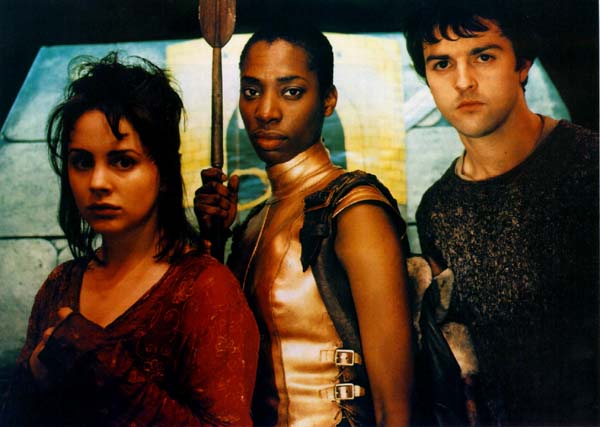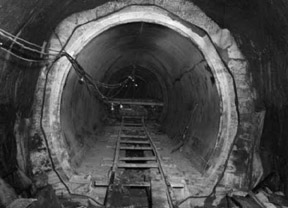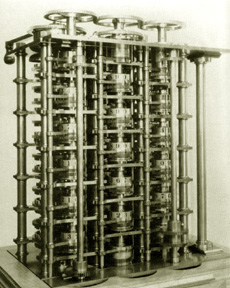Neverwhere and London
Below
The Neverwhere D6 role-playing is based on Neil Gaiman's novel Neverwhere.
Set in London, or rather London Below, the novel follows Richard Mayhew's
journey from a regular, cubicle-dwelling working stiff to tunnel-dwelling,
beast-slaying hero (even if it is all by accident).
London Below, as the name suggests, exists under London proper.
It also exists aside from "normal" London life. It is a completely
different world, based on feudal structures, magic and (apparently) some
very divergent laws of physics. These underdwellers live in the subway
tunnels, sewers, and forgotten catacombs that twist beneath the city.
Furthermore, time passes differently there: Roman centurions can
mix with post-modern punk rockers; day slips seamlessly into night, into
yesterday and then back into two days from now. When dealing with
the "structure" of London Below, it is best not to think about it too much.
There is no sensible answer and you'll only get a headache.
London Below is populated with all manner of people and creatures, most
of whom have "fallen through the cracks" of what the rest of us see as
reality. As such, "normal" folks do not even notice an underdweller
unless the he draws attention to himself. Underdwellers are essentially
invisible until noticed and are quickly forgotten once out of site of anyone
who does manage to notice them.
The world below is harsh, cruel and dangerous. Everything is for
barter and survival demands a combination of luck, wits and brutality.
It's best to make a few friends and secure a few favors in your debt.
There are little pockets of old time in London, where things and
places stay the same, like bubbles in amber.
--Door
Falling "Between the Cracks"
While many of the residents of the Underside were born into it, many
others arrive from the World Above on a regular basis. Those that
do usually fall into two categories: those that have "fallen between
the cracks" and those that have been "exposed" to underdwellers.
Those that have "fallen between the cracks" are usually those poor souls
that have gone largely unnoticed in the world. The homeless, the
abused, and the chronically lonely may be included in this category.
It may also include those that actively seek to escape the World Above
and find themselves in a whole new realm.
Those that have been "exposed" to underdwellers for too long may find
themselves transformed into an underdweller despite a well-rooted life
in the World Above. This is the case with Neverwhere's protagonist
Richard Mayhew. He had a good job, a fiancé, and many friends.
But his exposure to Door and the marquis de Carabas caused him to fall
between the cracks of society and into the Underside. It's not that
Richard ceased to exist Above—his belongings and even his history remained.
Only, no one above remembered him. The universe simply filled in
the gap where Richard once was. At best, his former friends would
vaguely recognize him, though be unable to place his name. And like
all other updwellers, they would forget him as soon as he was out of sight.
The Worlds Below
In Neverwhere, Gaiman alludes to other "Cities Below" in the world—specifically
Calcutta, Bangkok, New York and Berlin. In this game, undercities
exist beneath every major city in the world. Each shares some characteristics:
it is populated by those who have "fallen through the cracks"; ruled by
social structures bordering on anarchy; and is filled with adventure, danger
and magic. But each undercity is also unique, taking on the flavor
and history the appropriate city above. See the Undercities
of the World section.
The Hierarchies
Each City Below has its own system of social order (or lack thereof).
By and large, the dwellers have adopted feudal systems based on the medieval
societies of the countries beneath which they live. The Undercities
in America are a bit more flexible, with a combination of feudal titles,
modern "political" demagogueries, and gang-like mobs.
In every part of the Underside, many choose to swear fealty to a particularly
powerful force—be it a single, "royal" individual, a guild, tribe or religion.
These loyalties require regular attention—one must pay homage, provide
tithes, or come to the aid of one's brethren. But they also provide
a community for support and mutual defense. Those that choose to
go it alone risk greater dangers and more uncertainty.
Interacting with Your
Fellow Underdwellers
By and large, those Below view even their friends with a touch of suspicion.
It's a harsh world, where loyalties shift rapidly; it's best to rely
on one's own wits and resources. However, a few worthy souls do band
together, forming tribes or "families" that provide as much security as
one may hope for in any world.
But even with close-knit groups, all things are up for bargain.
Food, protection, information and all manners of goods get passed through
trade. Even favors provide the most valuable of currency. An
able underdweller will not only be quick with a knife, but sharp in a bargain.
The Floating Market
There's a truce in the market. If anyone hurt anyone
there, the whole of London Below would be down on them like a ton of sewage.
-Anaesthesia, one of the Rat-Speakers.
Every City Below has a marketplace where all goods and services
may be haggled for and purchased. Markets occur at least a few times
a week, never in the same place as the last (hence the term "floating").
The Markets occur in odd places: the retail floor of a department
store, the deck of an old aircraft carrier, or within other public places.
The Markets occur late at night and go unnoticed by updwellers (and their
technology) and when the Market closes, it leaves no trace behind.
(No, don't ask how or why...once again, that's just the way it is!).
Those Below hold a special connection with the Markets: they all
respect a truce of non-violence and against theft; they pass along the
location of the next market, even to enemies; and generally approach the
Market with a kind of communal conviviality.
Getting to the a Market may require a minor quest or adventure—it may
be a dangerous route, guarded by a puzzle or beast, or require some "price"
to be paid for entrance.
The Grand Bazaar
The Grand Bazaar exists aside from all the various Cities Below.
It is unclear where it is actually located—in facts, parts of the bazaar
simultaneously exist in different parts of the world. The Bazaar
is a nexus where all underdwellers, from all the Cities Below, may come.
As with the Floating Markets, a Truce of non-violence and against theft
is strictly enforced.
The Bazaar provides the most arcane and rare wares—those only whispered
of in the Markets. Need the fresh heart of a long-extinct animal
for a spell? How about information from the guy who built the first
tunnels beneath Rome? Or maybe you just need someone to help you
locate the fragment of your soul that was stolen from you last night while
you slept. The Bazaar is the place to go.
But getting there is not easy. Indeed, it is much more dangerous
than reaching any of the Floating Markets. It may take a journey
of days or weeks to find out where the Bazaar is, then pass through the
labyrinthine requirements to gain entrance. As always, the effort
will be fraught with danger, sacrifice, and dark magicks.
Note: The Grand Bazaar is something of my own creation.
I thought it appropriate to have a place where underdwellers from different
Cities Below could convene. Also, there should be some items too
rare to find in a Floating Market.
Getting Around
For one thing, there's a lot of walking around in the Underside.
Given the surroundings, most motorized vehicles are impractical—and that's
assuming that an underdweller could get them to work in the first place.
Furthermore, much of the technology will ignore, or even actively exclude,
an underdweller (yes, as if the technology has a mind of its own).
In the novel, Richard could not board a subway train—it slammed its doors
on him. Later, Door explained that they could ride some subway trains,
but you had to let the train "know who was boss."
That said, the those Below have discovered all sorts of alternative
methods for getting around quickly. Many learn which doors and pathways
provide quick connections to other locations located far away. In
its crassest form, it may seem to be a kind of teleportation—but that's
pigeon-holing a bit too much. For the game, the GM may provide these
various portals for sake of convenience or (better yet) adventure.
Technology in the Underside:
Though it is unclear from the novel, it appears that a modern technology
functions differently in the Underside than it does Above. Despite
the cutthroats, assassins, and other unsavory types, no one uses modern
weapons such as handguns, explosives, or tasers. Rather, the underdwellers
arm themselves with archaic weapons such as swords, clubs, crossbows and
spears. For the game, GM's and players should assume that if an underdweller
attempts to use a modern weapon, it simply won't work.
Some more harmless technology may function, at least sometimes.
For example, Hunter uses an electric flashlight. But Richard's digital
watch ceases to work when he "falls between the cracks" and becomes an
underdweller. It is easy to propose some strange paradoxes—what if
an underdweller attempts to drive a car, for example, will he be invisible,
will the car? In general, GM's should err on the side of simplicity:
the car simply doesn't work, or other drives recognize that someone is
driving the car, but just can't seem to recognize the face of the driver.
GM's should allow modern technology that does not imbalance the game—and
always reserve the right to say that something ceases to work (without
need to explain why).
There seems to be some very advanced and elegant forms of technology
that have developed in the Underside but gone undiscovered Above.
The holographic diary of Lord Portico (Door's father) is one such example.
These devices resemble 19th Century inventions, apparently pre-electric
in design and are likely to be quite valuable. GM's and players should
feel free to develop this divergent "steampunk" technology.
Playing Neverwhere
The Basics section will spell out the mechanics necessary to roll the
dice and do the accounting. But what's really important is the attitude
with which players and the GM approach the game.
First and foremost, don't try to make too much sense of the world.
In fact, whenever anything becomes too predictable, the GM should change
it. One of the greatest things about the book is that it makes no
sense at times: Richard may walk through a door on a roof during
the daytime and end up in the broom closet of his flat during that night.
Second, while combat is part of the game, Neverwhere is much more about
storytelling: suspense, mystery and character development.
There are probably better gaming "worlds" for playing a combat-heavy modern
fantasy game. (Besides, I'm guessing Neil would prefer it.)
Finally, as with all the games I've posted (and all games you play,
in my opinion), change the rules as you see fit. These are only guidelines
to help the GM and the players have a good time. Experiment, tweak
and outright revise!.
Design Notes
The Neverwhere D6 game is based on West End Game's D6 Classic, specifically
as laid out in its Star Wars games. I will try and point out where
I've added my own little twists.
I've based the game on the Neverwhere novel only. The book actually
came after a television show that ran in England on the BBC some years
ago. I've never seen the show, so I really can't add much to the
game from it (obviously). A movie has been in various stages of production
for years, but I'm not sure of its current status. If it ever gets
made, I'll alter the game accordingly.
Because this game is based on a book, I don't really have very many
images to go along with the text. This is unfortunate, since I think
images add a lot to a RPG. I will try to supplement the game with
some appropriate images and maps. But I am going to try an experiment:
instead of posting images to describe some aspects of the game, I'm going
to include excerpts from the novel. I will also add prose descriptions
of my own (with my own Neverwhere characters) to spice things up.
Let me know what you think.
Finally, there is at least one other "modern fantasy" RPG out there—Underworld
by Adamant Entertainment. I
have purposely not even picked up the game. I've read a couple of
reviews of it (both were favorable), but decided that I didn't want to
borrow from their game (even unintentionally). That said, it may
well add a lot to your Neverwhere game. Check them at: http://adamant.rpg.net/uw/index.html
. You might also find some useful resources in various "Steampunk"
games and comics.
The book Neverwhere is copyright Neil Gaiman, the TV series was copyright
to the BBC, and the gaming system is copyright West End Games. This
site is wholly unauthorized. Please don't sue me.
August 2002

